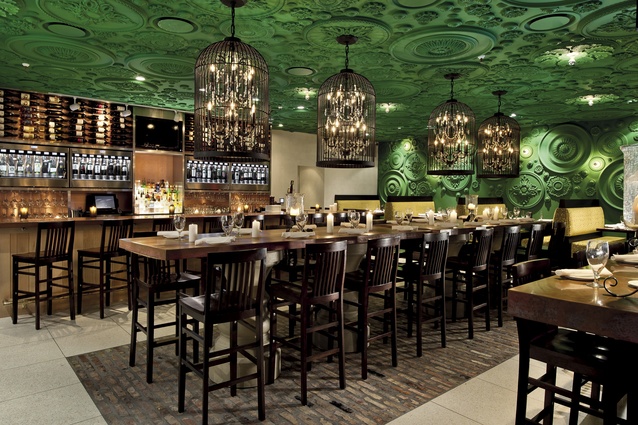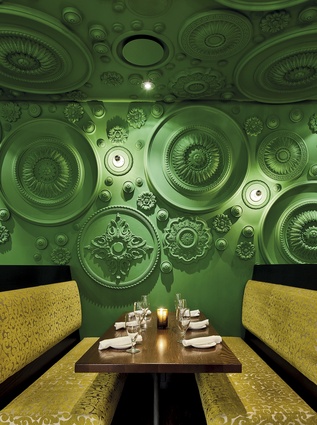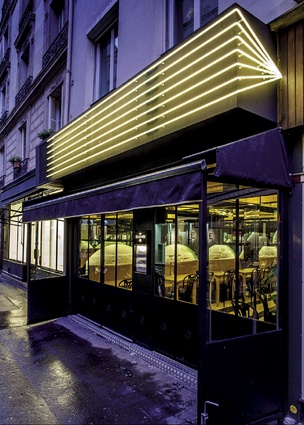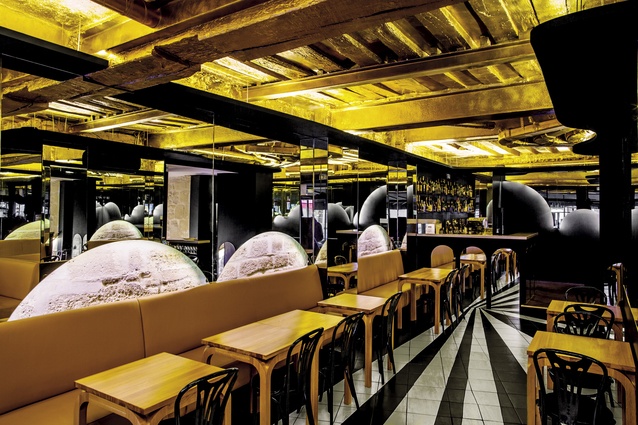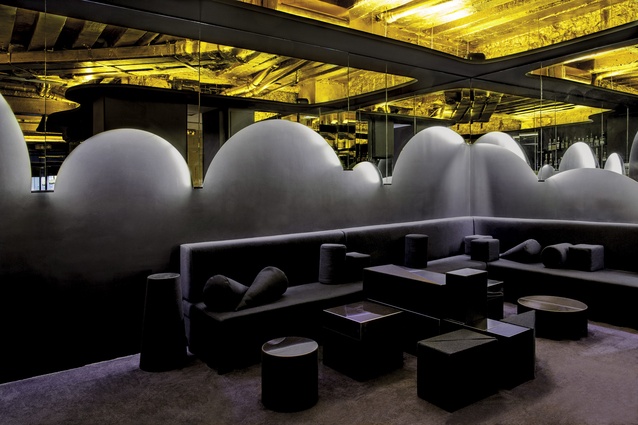Above the line
In Naples (Florida, USA) and Saint-Germain-des-Prés (Paris, France) Simon Bush-King discovers two very different restaurants that take unusual surface treatments to higher levels.
Les Cloches, a Parisian brasserie for a film director, and Barbatella, a restaurant in the well-heeled retirement town of Naples, Florida, would appear to have little in common. Despite distance and differences, both restaurants exemplify the bold gesture, pushed to the limit for the context and client for which it was created. The chic, urban brasserie and popular seaside hotspot are effusive, positive interiors that never lose sight of their reason for being – to connect great food with friends and family in a space that lifts the spirit.
Located in Saint-Germain-des-Prés, Les Cloches is at once lush, homely and surreal.
Design polymath José Levy was given carte blanche from film director Christophe Mura, who had full faith in the designer, who is well known in fashion industry circles.
Meanwhile, Barbatella is the culinary brainchild of Chef Fabrizio Aielli, who reached out to Washington DC-based GrizForm Design Architects. The experienced restaurateur appreciated GrizForm’s experience in creating well-put-together restaurants in DC, and convinced its designers to try their hand in the fairer climes of Florida.
Both restaurants grab your attention from above. The ceiling and walls of Barbatella are covered with 1,400 bright green plaster medallions, while Les Cloches plays with a surreal mix of oak beams, gold leaf and mirror. What really connects these two restaurants, however, is not their ceiling bling but the commitment to execute a project that takes great food, warm service and a comfortable environment as a starting point. In their own ways, both restaurants exceed their client’s expectations and leave a strong impression on all those who dine there.
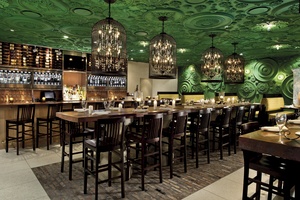
Barbatella
After 30 years in the restaurant business and at the top of his game, Chef Aielli moved to Naples in 2007. Griz Dwight describes how Aielli, unable to sit still, “Saw a market dominated by a casual big-plate scene, overly sauced and flavoured and not very healthy.”
Chef Aielli, familiar with GrizForm’s past work, called Dwight to say he loved his work and asked him if he wanted to work in Naples. Speaking with an Italian called Chef and hearing Naples, Dwight happily thought he’d be jetting off to Italy. Upon straightening out their geography, and with GrizForm on board, Aielli started high-end seafood Restaurant Sea Salt in 2007. With a further vision to create a ‘breakfast-to-cocktails’ spot with the same high standards, but in a more relaxed setting, the idea of Barbatella was born.
The restaurant and bar occupies two adjacent tenancies joined by a courtyard – the perfect addition to this winter-season town where temperatures regularly reach the late ’20s. The two sides take on different personalities. The restaurant side takes a refined rustic approach with brick floors, timber tables and terrazzo and copper finishes. The bar is more intense and decorative, with the bright green walls and ceilings throwing a bold punch without sending you spinning. Recalling the initial conversations over the green medallions, Dwight explains, “We started with a few medallions before stepping back and concluding that, if we were going to use them, we’d have to go all in!”
As construction progressed and despite the trust between Dwight and Chef Aielli from their previous ventures, Dwight still received three calls a day saying, “I trust you but I’m not sure about the green!”
Meanwhile, the contractor was calling Dwight saying it wouldn’t work and the fire department needed their hand carefully held as the design team proved the medallions would not send the restaurant up in flames.
Like many designers enjoying the anonymity of hanging out in a project post-completion, Dwight recalls what must pass for a James Bond moment for a designer, “I was listening to these two woman saying, ‘I would love to meet the person that came up with this, that guy must be crazy’. So I turned and introduced myself, ‘I’m Griz, nice to meet you’.”
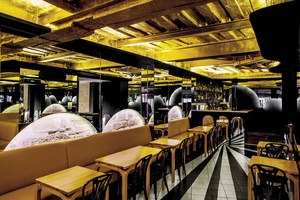
Les Cloches
Far removed from the bubble of Washington DC, or the sun of Naples, lies Les Cloches, in the famous neighbourhood of Saint-Germain-des-Prés. In what was once the epicentre of Parisian intellectual life, you’ll find that today’s patrons reflect the location – a mix of tourists and locals where the consumption of history tends to overshadow its output. Injecting a dining experience that both reflects a French tradition of eating, while being decidedly of its time, shows the skill of someone used to combining abstract ideas into an understandable narrative.
That it is difficult to pin José Levy down is not surprising. Well known as a menswear designer, he has tried his hand at a gamut of artistic productions. He explains, “I love to experience many things; I am very hyperactive.” Perhaps then, it is easier to surrender to the French and describe Levy as a créateur d’objet , and this creator of objects – with his history of idiosyncratic, yet relatable, projects – keeps the design industry asking for more.
À la mode of the pace of the fashion industry, the design of Les Cloches moved quickly. The concept was identified over a couple of meetings and Levy brought the influence of two restaurant typologies to bear on Les Cloches – which in English means ‘The Bells’. Mirror-lined brasseries with large leather seats and dark interiors are a Parisian staple and one with which Levy was both familiar and fond.
“I’m obsessed with mirrors – everything changes all the time, while they bring light inside.” Provincial countryside restaurants also influenced the design, with solid, safe tables and exposed stone. In Les Cloches, the arched mirrors against dark walls give the same result as the original by suggesting a much larger interior. A finer use of detail, albeit with a solid appearance, can be seen in the oak tables Levy designed for the space. The ceiling and floor both play with our perceptions. Gold leaf on rough-oak beams throws light around the space, while the tiled floor is painted with radiating black and white stripes, drawing attention from the entry towards the back of the brasserie. It is an effect only heightened by the abundant use of mirror.
To finish, there is a small salon at the rear of the brasserie, complete with a range of small movable furniture objects. As a social space, the black-steel elements are low to the floor, which is covered with black carpet. The small details are not overlooked and this reflects the free reign wielded by Levy. Friends came on board to help out. Elsie Obadai and Benjamin Moreau created music specifically for Les Cloches, while Dan Amzallag and Stéphane Manel created the graphic work on the interior and menu.
Levy states, happily, “I am more free today than ever before.” In this age of the specialist it is nice to see his playful hand at work.


